Deep learning is a powerful artificial intelligence technology that can learn features from a large amount of data and fit nonlinear networks, so it is widely used in the fields of computer vision, natural language processing, and speech recognition, and has achieved tremendous success. Since mobile communication networks are able to generate large amounts of different types of data at a very fast pace, relevant researchers have applied deep learning to the field of communication, bringing opportunities for the development of communication technologies. For example, signal modulation identification in wireless communication can be done using deep learning techniques, and deep learning-based modulation identification methods have better robustness than traditional AMR methods and higher accuracy rates. There are many excellent neural networks in deep learning, such as convolutional neural network (CNN, RNN), recurrent neural network (RNN), etc. Among them, CNN is good at processing image data and RNN is good at processing sequence signals. CNN and RNN are widely used in AMR. The application of these neural networks to deep learning is discussed.
- CNN
- deep learning
- RNNs
- modulation recognition
- intelligent signal processing
1. Application of Convolutional Neural Network in Modulation Recognition
1.1. Convolutional Neural Networks

1.2. The Modulation Recognition Method Based on Convolutional Neural Network
- 1.
-
A two-dimensional image recognition method based on CNN.
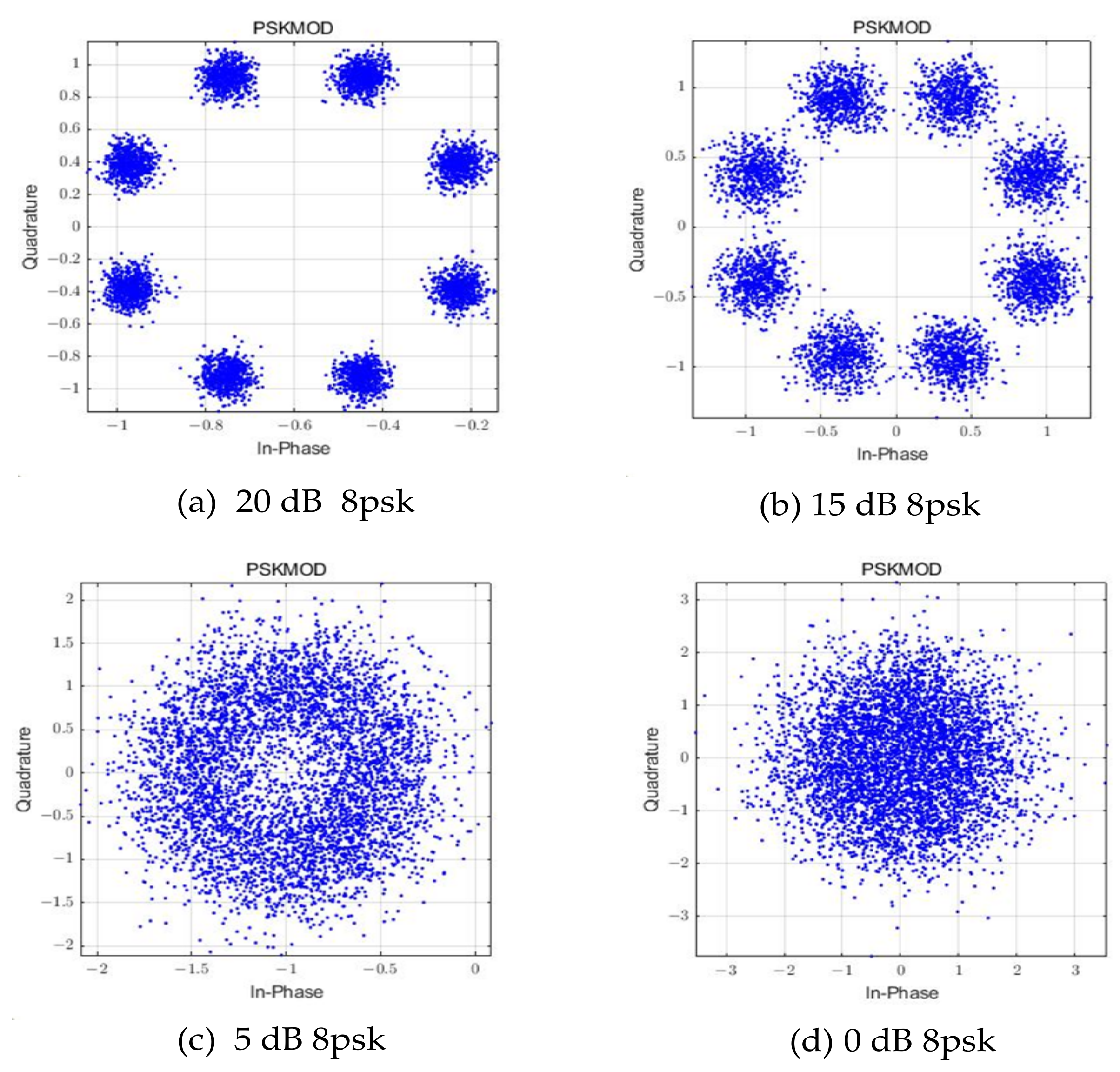
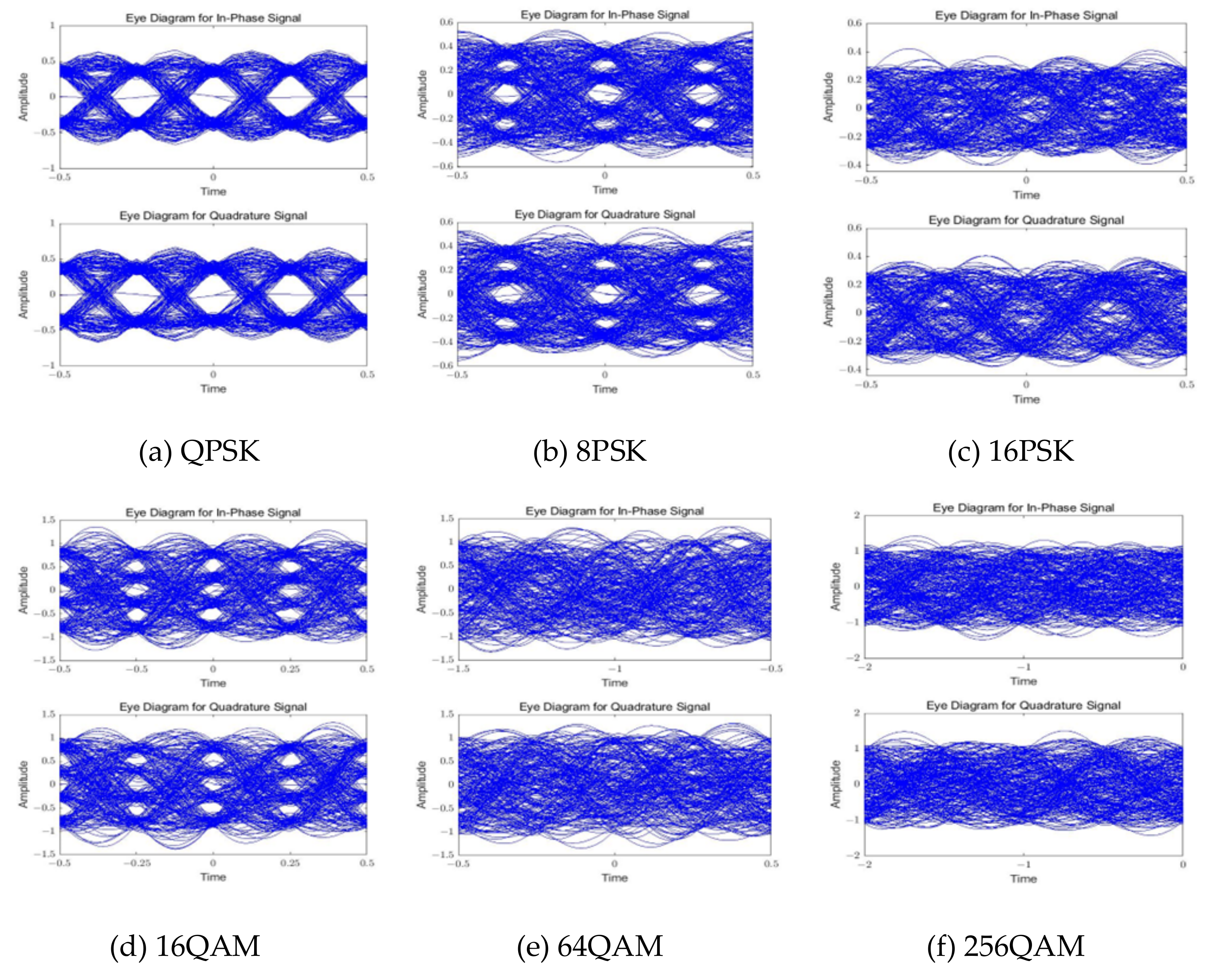
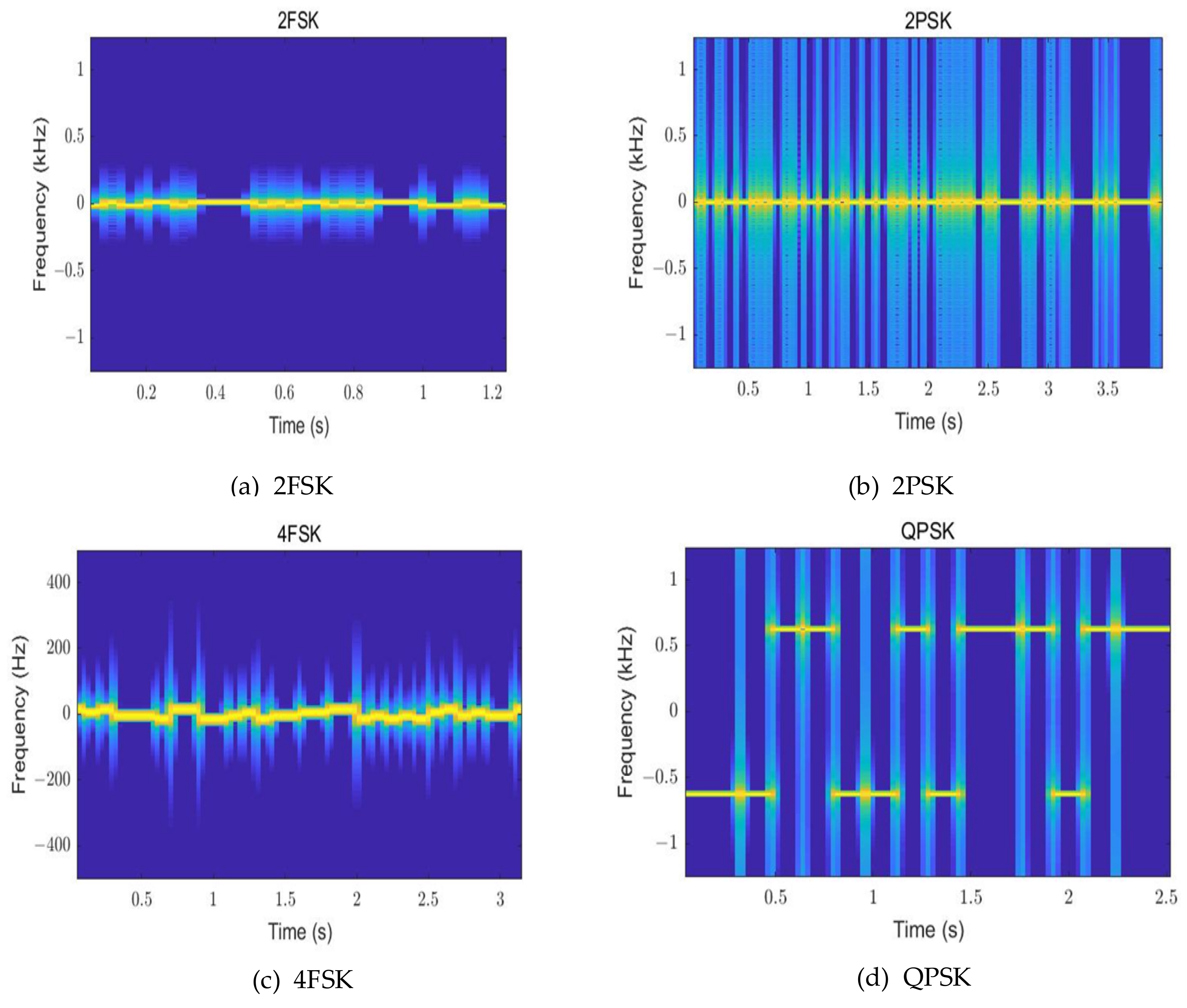
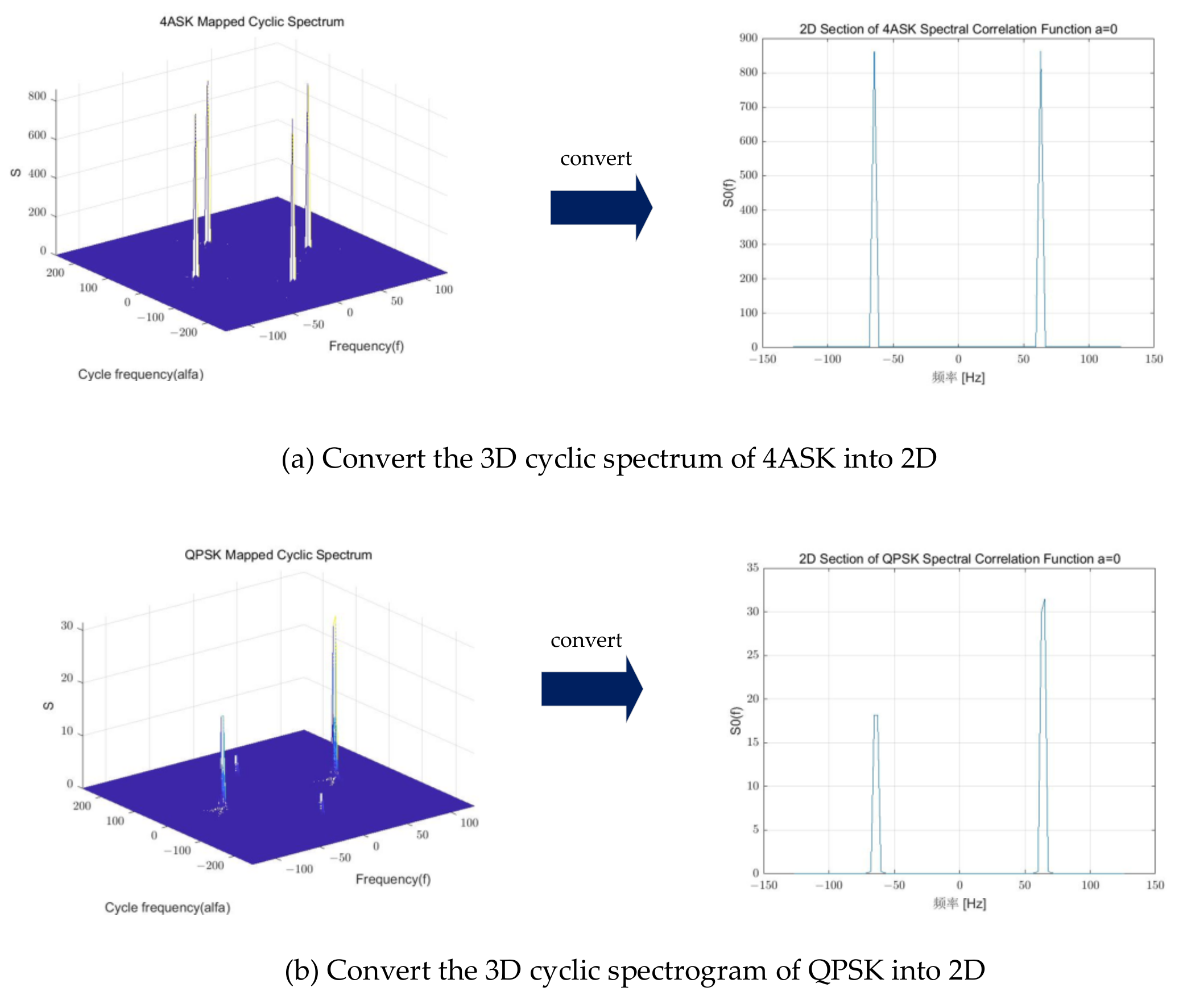
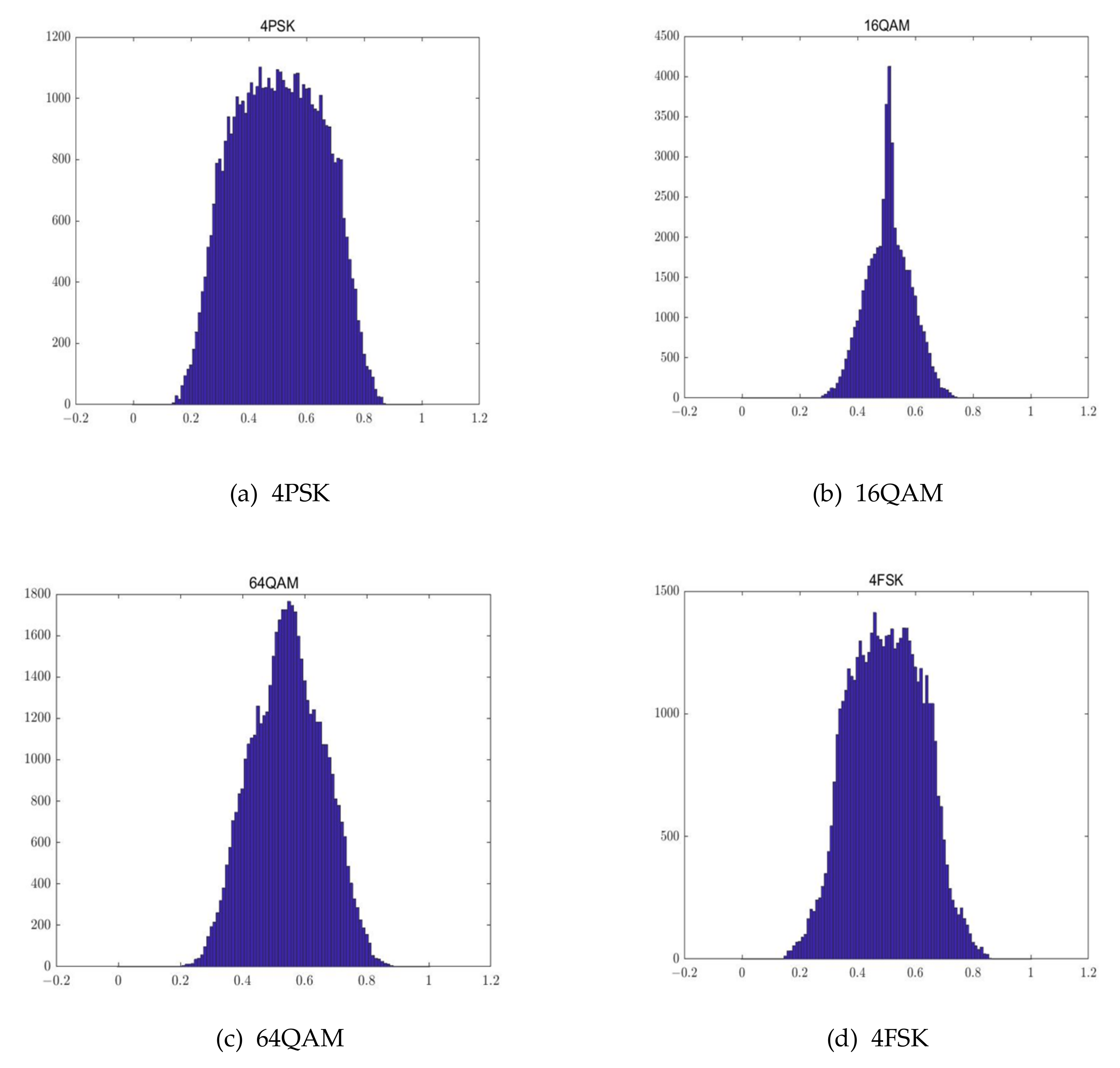
- 2.
-
The signal sequence recognition method based on CNN.
2. Application of the Recurrent Neural Network in Modulation Recognition
2.1. Recurrent Neural Networks
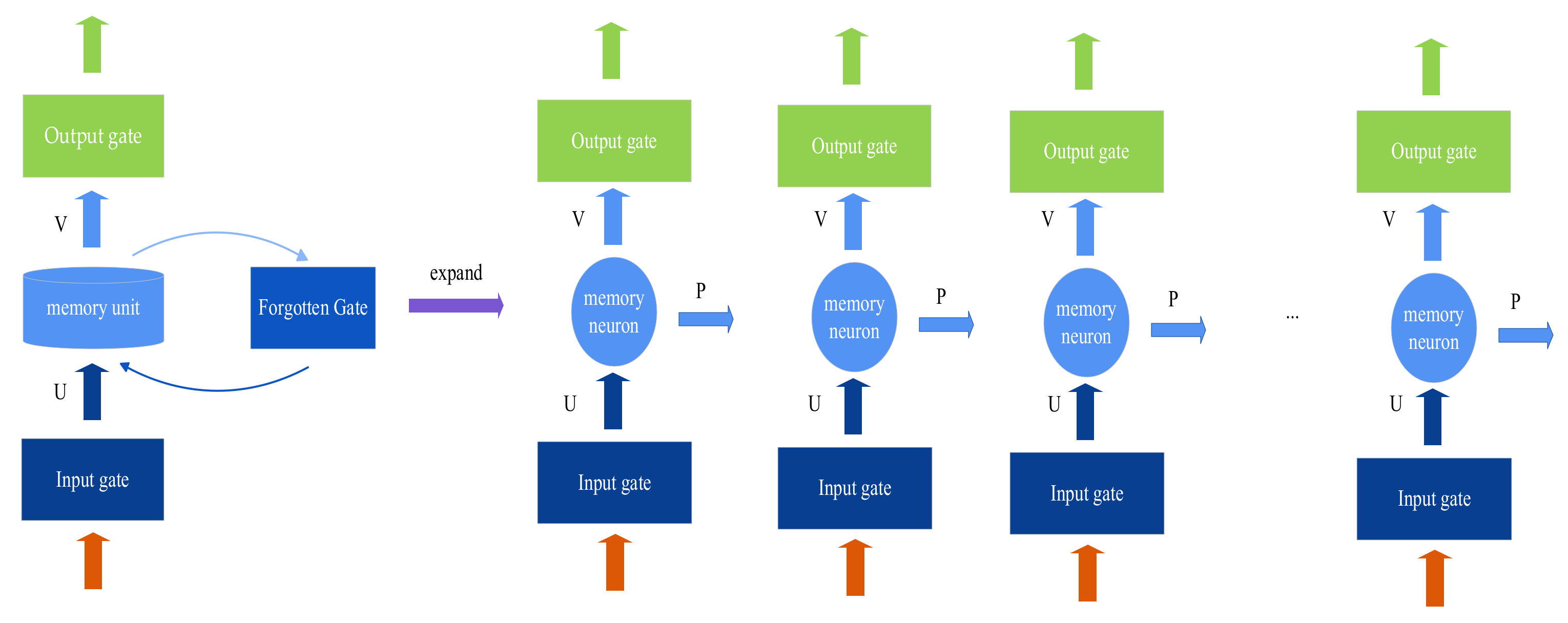
2.2. Modulation Recognition Based on Recurrent Neural Network
| Author | Year | Input Signal | Model | Modulation Signal Type | Recognition Accuracy |
|---|---|---|---|---|---|
| D. Hong et al. [32] | 2017 | IQ signal | Two-layer GRU | WB-FM, AM-SSB, AM- DSB, BPSK, QPSK, 8PSK, 16QAM, 64QAM, BFSK, CPFSK, PAM4 |
91% (−4 dB) |
| 2ASK, 4ASK, BPSK, QPSK, 8PSK, 64QAM | |||||
| 93.14% (10 dB) | |||||
| Duan, Q et al. [50] | 2021 | Original signal | MCBL (CNN + Bi LSTM + Attention) | 8PSK, AM-DSB, BPSK, CPFSK, GFSK, PAM4, QAM16, QAM64, QPSK, WBFM | 93% (0 dB) |
| Z. Liang et al. [51 | |||||
| UdayaDampage | |||||
| [39] | 2022 | IQ signal | LSTM + Bi LSTM | BPSK, QPSK, 16QAM, 64QAM, 256QAM | 90% (0 dB) |
| P. Ghasemzadeh [40] | 2022 | IQ signal | S-QRNN | OOK, 4ASK, 8ASK, BPSK, QPSK, 8PSK, 16PSK, 32PSK, 16APSK, 32APSK, 64APSK, 128APSK, 16QAM et | 90% (5 dB) |
3. Application of Combination Neural Network in Modulation Recognition
| Author | Year | Input Signal | Model | Modulation Signal Type | Recognition Accuracy | |||||
|---|---|---|---|---|---|---|---|---|---|---|
| B. Tang et al. [46] | 2018 | Outline constellation map | CNN + GAN | 4ASK, BPSK, OQPSK, 8PSK, 16QAM, 32QAM, 64QAM | 100% (−2 dB) | |||||
| Kim, H et al. [33] | 2019 | |||||||||
| F. Liu et al. [47 | Amplitude phase of IQ signal | ] | LSTM | 8PSK, AM-DSB-BPSK, PFSK, GFSK, PAM4, QAM16, QAM64, QPSK, WBFM | 80% (6 dB) | |||||
| 2020 | IQ sequence, cyclic spectrum | CNN + GRU | 2PSK, 2ASK, 2FSK, 4PSK, 4ASK, 16QAM, 64QAM | 100% (0 dB) | Wang, Yan et al. [34] | 2020 | IQ signal | HSNet | 16QAM, 32QAM, BPSK, QPSK, 8PSK, PAM, CPFSK, GFSK, FM, SSB | 86% (0 dB) |
| H. Yang et al. | ||||||||||
| J. Xu et al. [48] | 2021 | IQ sequence | MCLDNN(CNN + LSTM + FC) | WBFM, AM-DSB, AM-SSB, BPSK, CPFSK, GFSK, 4-PAM, 16-QAM, 64-QAM, QPSK, and 8PSK |
90% (0 dB) | [35] | 2021 | |||
| Jiang K et al. [49 | Polar coordinate representation of the signal | ] | IRS + LSTM | BPSK, QPSK, 8PSK, 16QAM, 64QAM, GFSK, CPFSK, 4PAM, WBFM, AM–DSB | 90% (0 dB) | |||||
| 2021 | IQ sequence | CNN + Bi LSTM + Attention | Liu et al. [36] | 2021 | IQ signal | DCN-BiLSTM | AM-DSB, AM-SSB, WBFM, BPSK, 8PSK, QPSK, CPFSK, GFSK, PAM4, 16QAM, 64QAM | 90% (4 dB) | ||
| Zi. et al. [37] | 2022 | IQ signal | LSTM | 8PSK, AM-DSB, AM-SSB, BPSK, CPFSK, GFSK, PAM4, QAM16, QAM64, QPSK, WBFM |
90% (8 dB) | |||||
| ] | 2021 | Time-frequency diagram | ResNeXt WSL(ResNeXt + Attention) | 8PSK, BPSK, AM-DSB, QPSK, QAM16, QAM64, CPFSK, GFSK, PAM4, and WBFM, |
90% (0 dB) | V.N.Senthil Kumaran [38] | 2022 | |||
| S. Chang et al. [52 | Original signal | EDL-MSC (GRU + Bi LSTM + SSAE) | 8PSK, BPSK, 16QAM, 64QAM, QPSK | 92% (−4 dB) | ||||||
| ] | 2022 | Sampled signal | MLDNN(CNN + Bi GRU + SAFN) | AM-DSB, AM-SSB, WBFM. 8PSK, BPSK, CPFSK, GFSK, 4PAM, 16QAM, 64QAM, QPSK |
84% (0 dB) | |||||
| W. Zhang et al. [53] | 2022 | Sampled signal | GRU + CNN | BPSK, QPSK, BFSK, QFSK, 16QAM, 64QAM, OFDM | 99.45% (true channel) | |||||
| Zou B et al. [54] | 2022 | IQ sequence | ASCLDNN (Attention + CLDNN) | BPSK, 8PSK, CPFSK, GFSK, PAM4, PAM16, QAM64, QPSK, AM-DSB, AM-SSB, WBFM | 90% (0 dB) | |||||
| Bai J et al. [55] | 2022 | IQ sequences and GAF images | DMFF-CNN (Complex Value Network + ResNet50) | 2FSK, AM, DSB, FM, OFDM, QAM16, QPSK, SSB | 91% (−10 dB) |
4. Applications of Other Neural Networks in Modulation Recognition
References
- Peng, S.; Jiang, H.; Wang, H.; Alwageed, H.; Zhou, Y.; Sebdani, M.; Yao, Y. Modulation Classification Based on Signal Constella-tion Diagrams and Deep Learning. IEEE Trans. Neural Netw. Learn. Syst. 2019, 30, 718–727.
- Tian, X.; Chen, C. Modulation Pattern Recognition Based on Resnet50 Neural Network. In Proceedings of the 2019 IEEE 2nd International Conference on Information Communication and Signal Processing (ICICSP), Weihai, China, 28–30 September 2019; pp. 34–38.
- An, Z.; Zhang, T.; Shen, M.; De Carvalho, E.; Ma, B.; Yi, C.; Song, T. Series-Constellation Feature Based Blind Modulation Recognition for Beyond 5G MIMO-OFDM Systems with Channel Fading. IEEE Trans. Cogn. Commun. Netw. 2022, 8, 793–811.
- Wang, D.; Zhang, M.; Li, Z.; Li, J.; Fu, M.; Cui, Y.; Chen, X. Modulation Format Recognition and OSNR Estimation Using CNN-Based Deep Learning. IEEE Photonics Technol. Lett. 2017, 29, 1667–1670.
- Li, Z.; Zha, X. Modulation Recognition Based on IQ-eyes Diagrams and Deep Learning. In Proceedings of the 2019 IEEE 5th International Conference on Computer and Communications (ICCC), Chengdu, China, 6–9 December 2019; pp. 1570–1574.
- Zha, X.; Peng, H.; Qin, X.; Li, G.; Yang, S. A Deep Learning Framework for Signal Detection and Modulation Classification. Sensors 2019, 19, 4042.
- Mao, Y.; Ren, W.; Yang, Z. Radar Signal Modulation Recognition Based on Sep-ResNet. Sensors 2021, 21, 7474.
- Quan, D.; Tang, Z.; Wang, X.; Zhai, W.; Qu, C. LPI Radar Signal Recognition Based on Dual-Channel CNN and Feature Fusion. Symmetry 2022, 14, 570.
- Tian, X.; Sun, X.; Yu, X.; Li, X. Modulation Pattern Recognition of Communication Signals Based on Fractional Low-Order Choi-Williams Distribution and Convolutional Neural Network in Impulsive Noise Environment. In Proceedings of the 2019 IEEE 19th International Conference on Communication Technology (ICCT), Xi’an, China, 16–19 October 2019; pp. 188–192.
- Jing, G.; Fan, L.; Yang, L. Modulation recognition algorithm using innovative CNN and cyclic-spectrum graph. In Proceedings of the 2019 14th IEEE International Conference on Electronic Measurement & Instruments (ICEMI), Changsha, China, 1–3 November 2019; pp. 466–473.
- Liu, R.; Guo, Y.; Zhu, S. Modulation Recognition Method of Complex Modulation Signal Based on Convolution Neural Net-work. In Proceedings of the 2020 IEEE 9th Joint International Information Technology and Artificial Intelligence Conference (ITAIC), Chongqing, China, 11–13 December 2020; pp. 1179–1184.
- Lv, H.; Zhou, X.; Huo, J.; Yuan, J. Joint OSNR monitoring and modulation format identification on signal amplitude histo-grams using convolutional neural network. Opt. Fiber Technol. 2021, 61, 102455.
- Guan, Q.; Zhang, Y.J. Cyclic Cumulant Based on Communication Signal Multilayer Neural Network Modulation Pattern Recognition. CCIOT 2018, 10, 595–600.
- Hong, S.; Zhang, Y.; Wang, Y.; Gu, H.; Gui, G.; Sari, H. Deep Learning-Based Signal Modulation Identification in OFDM Systems. IEEE Access 2019, 7, 114631–114638.
- De, L.; Jian, X.; Chang, X.; Peng, F. A modulation recognition method based on enhanced data representation and convolu-tional neural network. IMCEC 2021, 4, 187–191.
- Wang, Y.; Gui, J.; Yin, Y.; Wang, J.; Sun, J.; Gui, G.; Gacanin, H.; Sari, H.; Adachi, F. Automatic Modulation Classification for MIMO Systems via Deep Learning and Zero-Forcing Equalization. IEEE Trans. Veh. Technol. 2020, 69, 5688–5692.
- Huynh-The, T.; Nguyen, T.V.; Pham, Q.V.; da Costa, D.B.; Kim, D.S. MIMO-OFDM Modulation Classification Using Three-Dimensional Convolutional Network. IEEE Trans. Veh. Technol. 2022, 71, 6738–6743.
- Reichert, J. Automatic classification of communication signals using higher order statistics. In Proceedings of the ICASSP, San Francisco, CA, USA, 23–26 March 1992; 5, pp. 221–224.
- Wang, L.; Ren, Y. Recognition of digital modulation signals based on high order cumulants and support vector machines. In Proceedings of the 2009 ISECS International Colloquium on Computing, Communication, Control, and Management, Sanya, China, 8–9 August 2009; pp. 271–274.
- Zhao, Y.; Xu, Y.; Jiang, H.; Luo, Y.; Wang, Z. Recognition of digital modulation signals based on high-order cumulants. In Proceedings of the 2015 International Conference on Wireless Communications & Signal Processing (WCSP), Nanjing, China, 15–17 October 2015; pp. 1–5.
- Li, Y.; Guo, X.; Zhao, X. Study on Modulation ecognition Based on Higher-order Cumulants. J. Southwest Univ. Sci. Technol. 2018, 33, 64–68.
- Wang, Y.; Wang, J.; Zhang, W.; Yang, J.; Gui, G. Deep Learning-Based Cooperative Automatic Modulation Classification Method for MIMO Systems. IEEE Trans. Veh. Technol. 2020, 69, 4575–4579.
- Song, Q.; Wu, Y.; Soh, Y.C. Robust adaptive gradient-descent training algorithm for recurrent neural networks in discrete time domain. IEEE Trans. Neural Netw. 2008, 19, 1841–1853.
- Zhang, M.; Zeng, Y.; Han, Z.; Gong, Y.C. Automatic modulation recognition using deep learning architectures. In Proceedings of the 2018 IEEE 19th International Workshop on Signal Processing Advances in Wireless Communications (SPAWC), Kalamata, Greece, 25–28 June 2018; pp. 1–5.
- Li, X.; Huang, Z.; Wang, F.; Wang, X.; Liu, T. Toward convolutional neural networks on pulse repetition interval modulation recognition. IEEE Commun. Lett. 2008, 22, 2286–2289.
- Norgren, E.J.D. Pulse repetition interval modulation classification using machine learning. Ph.D. Thesis, KTH Royal Institute of Technology, Stockholm, Sweden, 11 January 2019.
- Li, X.; Liu, Z.; Huang, Z. Attention-Based Radar PRI Modulation Recognition with Recurrent Neural Networks. IEEE Access 2020, 8, 57426–57436.
- Zhang, B.; Chen, G.; Jiang, C. Research on Modulation Recognition Method in Low SNR Based on LSTM. J. Phys. Conf. Ser. 2022, 2189, 012003.
- Wei, S.; Qu, Q.; Zeng, X.; Liang, J.; Shi, J.; Zhang, X. Self-Attention Bi-LSTM Networks for Radar Signal Modulation Recogni-tion. IEEE Trans. Microw. Theory Tech. 2021, 69, 5160–5172.
- Jing, Q.; Wang, H.; Yang, L. Study on Fast-Changing Mixed-Modulation Recognition Based on Neural Network Algorithms. KSII 2020, 14, 4664–4681.
- Kong, W.; Yang, Q.; Jiao, X.; Niu, Y.; Ji, G. A Transformer-based CTDNN Structure for Automatic Modulation Recognition. In Proceedings of the 2021 7th International Conference on Computer and Communications (ICCC), Chengdu, China, 10–13 December 2021; pp. 159–163.
- Hong, D.; Zhang, Z.; Xu, X. Automatic modulation classification using recurrent neural networks. In Proceedings of the 2017 3rd IEEE International Conference on Computer and Communications (ICCC), Chengdu, China, 13–16 December 2017; pp. 695–700.
- Kim, H.; Je, J.; Kim, K. A deep learning method for the automatic modulation recognition of received radio signals. J. Korea Inst. Inf. Commun. Eng. 2019, 23, 1275–1281.
- Wang, Y.; Zhang, H.; Xu, L.; Cong, C.T.; Gulliver, A. Adoption of hybrid time series neural network in the underwater acoustic signal modulationn identification. J. Frankl. Inst. 2020, 357, 13906–13922.
- Yang, H.; Zhao, L.; Yue, G.; Ma, B.; Li, W. IRLNet: A Short-Time and Robust Architecture for Automatic Modulation Recognition. IEEE Access 2021, 9, 143661–143676.
- Liu, K.; Gao, W.; Huang, Q. Automatic Modulation Recognition Based on a DCN-BiLSTM Network. Sensors 2021, 21, 1577.
- Ke, Z.; Vikalo, H. Real-Time Radio Technology and Modulation Classification via an LSTM Auto-Encoder. IEEE Trans. Wirel. Commun. 2022, 21, 370–382.
- Senthil, N.; Ganesan, I.; Vijay, M. Ensemble of Deep Learning Enabled Modulation Signal. Wirel. Commun.-Tions Mob. Comput. 2022, 10, 1307715.
- Dampage, U.; Amarasooriya, R.; Samarasinghe, S.; Karunasingha, N. Combined Classifier-Demodulator Scheme Based on LSTM Architecture. Wirel. Commun. Mob. Comput. 2022, 2022, 1–9.
- Ghasemzadeh, P.; Hempel, M.; Sharif, H. High-Efficiency Automatic Modulation Classifier for Cognitive Radio IoT. IEEE Internet Things J. 2022, 9, 9467–9477.
- West, N.E.; O’Shea, T. Deep architectures for modulation recognition. In Proceedings of the 2017 IEEE International Symposium on Dynamic Spectrum Access Networks (DySPAN), Baltimore, MD, USA, 6–9 March 2017; pp. 1–6.
- Wang, T.; Hou, Y.; Zhang, H.; Guo, Z. Deep Learning Based Modulation Recognition with Multi-Cue Fusion. IEEE Wirel. Commun. Lett. 2021, 10, 1757–1760.
- Chen, S.; Zhang, Y.; He, Z.; Nie, J.; Zhang, W. A Novel Attention Cooperative Framework for Automatic Modulation Recogni-tion. IEEE Access 2020, 8, 15673–15686.
- Njoku, J.N.; Morocho-Cayamcela, M.E.; Lim, G.D. Net: Efficient Hybrid Deep Learning Model for Robust Automatic Modu-lation Recognition. IEEE Netw. Lett. 2021, 3, 47–51.
- Jiang, J.; Wang, Z.; Zhao, H.; Qiu, S.; Li, L. Modulation recognition method of satellite communication based on CLDNN model. In Proceedings of the 2021 IEEE 30th International Symposium on Industrial Electronics (ISIE), Kyoto, Japan, 20–23 June 2021; pp. 1–6.
- Tang, B.; Tu, Y.; Zhang, Z.; Lin, Y. Digital Signal Modulation Classification with Data Augmentation Using Generative Adversarial Nets in Cognitive Radio Networks. IEEE Access 2018, 6, 15713–15722.
- Liu, F.; Zhang, Z.; Zhou, R. Automatic modulation recognition based on CNN and GRU. Tsinghua Sci. Technol. 2022, 27, 422–431.
- Xu, J.; Luo, C.; Parr, G.; Luo, Y. A Spatiotemporal Multi-Channel Learning Framework for Automatic Modulation Recognition. IEEE Wirel. Commun. Lett. 2020, 9, 1629–1632.
- Jiang, K.; Qin, X.; Zhang, J.; Wang, A. Modulation Recognition of Communication Signal Based on Convolutional Neural Network. Symmetry 2021, 13, 2302.
- Qiang, D.; Jian, F.; Xiang, W.; Chao, W.; Xiang, J.; Nan, W. Automatic Modulation Recognition Based on Hybrid Neural Network. Wirel. Commun. Mob. Comput. 2021, 2021, 1530–8669.
- Liang, Z.; Tao, M.; Wang, L.; Su, J.; Yang, X. Automatic Modulation Recognition Based on Adaptive Attention Mechanism and ResNeXt WSL Model. IEEE Commun. Lett. 2021, 25, 2953–2957.
- Chang, S.; Huang, S.; Zhang, R.; Feng, Z.; Liu, L. Multitask-Learning-Based Deep Neural Network for Automatic Modulation Classification. IEEE Internet Things J. 2022, 9, 2192–2206.
- Zhang, W.; Yang, X.; Leng, C.; Wang, J.; Mao, S. Modulation Recognition of Underwater Acoustic Signals using Deep Hybrid Neural Networks. IEEE Trans. Wirel. Commun. 2022, 1, 5977–5988.
- Zou, B.; Zeng, X.; Wang, F. Research on Modulation Signal Recognition Based on CLDNN Network. Electronics 2022, 11, 1379.
- Bai, J.; Yao, J.; Qi, J.; Wang, L. Electromagnetic Modulation Signal Classification Using Dual-Modal Feature Fusion CNN. Entropy 2022, 24, 700.
- Ahmed, K.A.; Ergun, E. Automatic modulation classification using different neural network and PCA combinations. Expert Syst. Appl. 2021, 178, 114931.
- Xie, W.; Hu, S.; Yu, C.; Zhu, P.; Peng, X.; Ouyang, J. Deep Learning in Digital Modulation Recognition Using High Order Cumulants. IEEE Access 2019, 7, 63760–63766.
- Han, H.; Ren, Z.; Li, L.; Zhu, Z. Automatic Modulation Classification Based on Deep Feature Fusion for High Noise Level and Large Dynamic Input. Sensors 2021, 21, 2117.
- Si, L.; Tian, W.; Shao, W. Toward intelligent wireless communications: Deep learning-based physical layer technologies. Digit. Commun. Netw. 2021, 7, 589–597.
- Ya, W.; Zhi, L.; Chun, L.; Yu, C.; Chao, W.; Yi, C.; Yi, L. Research on Pulse Position Modulation and Demodulation System of Space Laser Communication Based on DBN-SVM. In Proceedings of the 2021 13th International Conference on Advanced Infocomm Technology (ICAIT), Yanji, China, 15–18 October 2021; pp. 105–109.
- Zhou, D.; Wang, X.; Tian, Y.; Wang, R. A novel radar signal recognition method based on a deep restricted Boltzmann machine. Eng. Rev. 2017, 37, 165–172.
- Zhang, C.; Yu, S.; Li, G.; Xu, Y. The Recognition Method of MQAM Signals Based on BP Neural Network and Bird Swarm Algorithm. IEEE Access 2021, 9, 36078–36086.
- Fang, Z.; Shen, J.; Zhou, X. Research on Digital Modulation recognition based on BP neural Network. ITOEC 2022, 6, 1813–1817.
